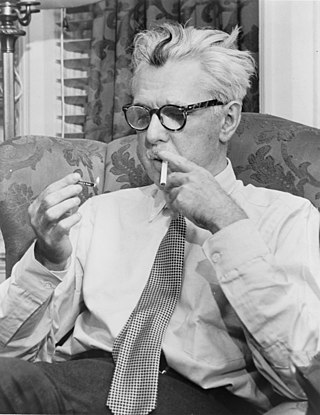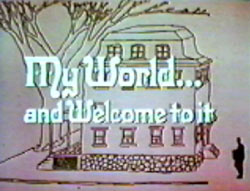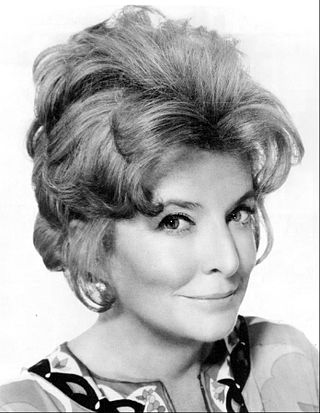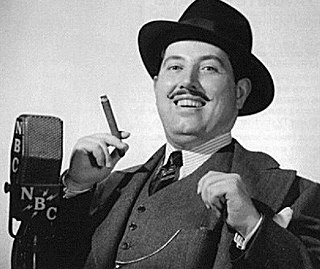
Fable is a literary genre defined as a succinct fictional story, in prose or verse, that features animals, legendary creatures, plants, inanimate objects, or forces of nature that are anthropomorphized, and that illustrates or leads to a particular moral lesson, which may at the end be added explicitly as a concise maxim or saying.

James Grover Thurber was an American cartoonist, writer, humorist, journalist and playwright. He was best known for his cartoons and short stories, published mainly in The New Yorker and collected in his numerous books.

The New Yorker is an American magazine featuring journalism, commentary, criticism, essays, fiction, satire, cartoons, and poetry. Founded as a weekly in 1925, the magazine is published 47 times annually, with five of these issues covering two-week spans. Although its reviews and events listings often focus on the cultural life of New York City, The New Yorker also produces long-form journalism and shorter articles and commentary on a variety of topics, has a wide audience outside New York, and is read internationally.

My World ... and Welcome to It is an American half-hour television sitcom based on the humor and cartoons of James Thurber.

Mary Margaret "Peggy" Cass was an American actress, comedian, game show panelist, and announcer.

Jane Therese Curtin is an American actress and comedian.
Walter Jackson Mitty is a fictional character in James Thurber's first short story "The Secret Life of Walter Mitty", first published in The New Yorker on March 18, 1939, and in book form in My World—and Welcome to It in 1942. Thurber loosely based the character, a daydreamer, on himself. It was made into a film in 1947 starring Danny Kaye, with a remake in 2013 directed by, and starring Ben Stiller.

Oliver Burgess Meredith was an American actor and filmmaker whose career encompassed theater, film, and television.

The Great Gildersleeve is a radio situation comedy broadcast in the United States from August 31, 1941 to 1958. Initially written by Leonard Lewis Levinson, it was one of broadcast history's earliest spin-off programs. The series was built around Throckmorton P. Gildersleeve, a regular character from the radio situation comedy Fibber McGee and Molly. The character was introduced in the October 3, 1939, episode of that series. Actor Harold Peary had played a similarly named character, Dr. Gildersleeve, on earlier episodes. The Great Gildersleeve enjoyed its greatest popularity in the 1940s. Peary played the character during its transition from the parent show into the spin-off and later in four feature films released at the height of the show's popularity.

Imogene Coca was an American comic actress best known for her role opposite Sid Caesar on Your Show of Shows. Starting out in vaudeville as a child acrobat, she studied ballet and wished to have a serious career in music and dance, graduating to decades of stage musical revues, cabaret and summer stock. In her 40s, she began a celebrated career as a comedian on television, starring in six series and guest starring on successful television programs from the 1940s to the 1990s.
"The Secret Life of Walter Mitty" (1939) is a short story by James Thurber. The most famous of Thurber's stories, it first appeared in The New Yorker on March 18, 1939, and was first collected in his book My World and Welcome to It. It has since been reprinted in James Thurber: Writings and Drawings, is available on-line on the New Yorker website, and is one of the most anthologized short stories in American literature. The story is considered one of Thurber's "acknowledged masterpieces". It was made into a 1947 film of the same name, with Danny Kaye in the title role, though the film is very different from the original story. It was also adapted into a 2013 film, which is again very different from the original.
Brendan Gill was an American journalist. He wrote for The New Yorker for more than 60 years. Gill also contributed film criticism for Film Comment, wrote about design and architecture for Architectural Digest and wrote fifteen books, including a popular book about his time at the New Yorker magazine.

"The Unicorn in the Garden" is a short story written by James Thurber. One of the most famous of Thurber's humorous modern fables, it first appeared in The New Yorker on October 21, 1939; and was first collected in his book Fables for Our Time and Famous Poems Illustrated. The fable has since been reprinted in The Thurber Carnival, James Thurber: Writings and Drawings, The Oxford Book of Modern Fairy Tales, and other publications. It is taught in literature and rhetoric courses.
Helen Elna Hokinson was an American cartoonist and a staff cartoonist for The New Yorker. Over a 20-year span, she contributed 68 covers and more than 1,800 cartoons to The New Yorker.

The Secret Life of Walter Mitty is a 1947 American Technicolor comedy film, loosely based on the 1939 short story of the same name by James Thurber. The film stars Danny Kaye as a young daydreaming proofreader for a magazine publishing firm and Virginia Mayo as the girl of his dreams. The film was adapted for the screen by Ken Englund, Everett Freeman, and Philip Rapp (uncredited), and directed by Norman Z. McLeod.

Simon Rich is an American humorist, novelist, and screenwriter. He has published two novels and six collections of humor pieces, several of which appeared in The New Yorker. His novels and short stories have been translated into over a dozen languages. Rich was one of the youngest writers ever hired on Saturday Night Live, and served as a staff writer for Pixar. On January 14, 2015, Man Seeking Woman, a television comedy series created by Rich premiered on the cable channel FXX.

Haila Stoddard was an American actress, producer, writer and director.
"The Rabbits who caused all the Trouble" is a short modern fable written by James Thurber. It first appeared in The New Yorker on August 26, 1939; and was first collected in his book Fables for Our Time and Famous Poems Illustrated. The fable has since been reprinted in The Thurber Carnival, James Thurber: Writings and Drawings, The Oxford Book of Modern Fairy Tales, and other publications. The story is often used in classes that teach English as a second language.
"A Couple of Hamburgers" is a 1935 short story by James Thurber, the American writer, considered to be one of his best.
"The Catbird Seat" is a 1942 short story by James Thurber. The story first appeared in The New Yorker on November 14, 1942. The story was also published in the 1945 anthology The Thurber Carnival.













